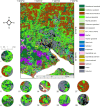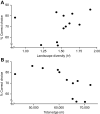The impact of landscape complexity and composition on honey bee visual learning
- PMID: 40554751
- PMCID: PMC12268175
- DOI: 10.1242/jeb.250057
The impact of landscape complexity and composition on honey bee visual learning
Abstract
Over the past few decades there has been an overall decline in the number of pollinators, including wild bees, partly due to stress factors such as the availability of food resources, nest site availability and pesticide usage. Managed honey bees have also been negatively impacted in certain regions, such as the USA. One of the major stress factors facing bees currently is land use change, where natural landscapes are decreasing and often converted to either agricultural or urban land. Here, we assess directly the link between landscape diversity, edge density and honey bee learning, by analysing how honey bee visual learning ability varies across different landscapes, using a field-adapted version of the proboscis extension response. It was previously thought that honey bees from hives based in different landscapes may vary in visual learning abilities because of their different experiences and neural plasticity. Thus, bees that have experience in more complex learning environments may do better in learning tasks. To test this, bees were taught to associate a coloured yellow paper strip with a positive sugar reward and a blue coloured strip with a negative salt reward. Results showed that as edge density increased in the landscape, visual learning in bees reduced, and when landscape diversity increased, so did learning. This is important as bees must learn foraging routes, find profitable flowers and develop spatial maps, as well as recognise intruders. If their cognitive abilities are reduced and they are unable to carry out these tasks, this will be detrimental for the continuous development of the colony.
Keywords: Apis; Apidae; Honey bee; Landscape; Learning.
© 2025. Published by The Company of Biologists.
Conflict of interest statement
Competing interests The authors declare no competing or financial interests.
Figures




Similar articles
-
The Black Book of Psychotropic Dosing and Monitoring.Psychopharmacol Bull. 2024 Jul 8;54(3):8-59. Psychopharmacol Bull. 2024. PMID: 38993656 Free PMC article. Review.
-
"In a State of Flow": A Qualitative Examination of Autistic Adults' Phenomenological Experiences of Task Immersion.Autism Adulthood. 2024 Sep 16;6(3):362-373. doi: 10.1089/aut.2023.0032. eCollection 2024 Sep. Autism Adulthood. 2024. PMID: 39371355
-
Sexual Harassment and Prevention Training.2024 Mar 29. In: StatPearls [Internet]. Treasure Island (FL): StatPearls Publishing; 2025 Jan–. 2024 Mar 29. In: StatPearls [Internet]. Treasure Island (FL): StatPearls Publishing; 2025 Jan–. PMID: 36508513 Free Books & Documents.
-
Short-Term Memory Impairment.2024 Jun 8. In: StatPearls [Internet]. Treasure Island (FL): StatPearls Publishing; 2025 Jan–. 2024 Jun 8. In: StatPearls [Internet]. Treasure Island (FL): StatPearls Publishing; 2025 Jan–. PMID: 31424720 Free Books & Documents.
-
Signs and symptoms to determine if a patient presenting in primary care or hospital outpatient settings has COVID-19.Cochrane Database Syst Rev. 2022 May 20;5(5):CD013665. doi: 10.1002/14651858.CD013665.pub3. Cochrane Database Syst Rev. 2022. PMID: 35593186 Free PMC article.
References
-
- Beekman, M., Sumpter, D. J. T., Seraphides, N. and Ratnieks, F. L. W. (2004). Comparing foraging behaviour of small and large honey-bee colonies by decoding waggle dances made by foragers. Funct. Ecol. 18, 829-835. 10.1111/j.0269-8463.2004.00924.x - DOI
-
- Cappellari, A., Malagnini, V., Fontana, P., Zanotelli, L., Tonidandel, L., Angeli, G. and Marini, L. and Marini, L. (2024). Impact of landscape composition on honey bee pollen contamination by pesticides: a multi-residue analysis. Chemosphere 349, 140829. 10.1016/j.chemosphere.2023.140829 - DOI - PubMed
MeSH terms
Grants and funding
LinkOut - more resources
Full Text Sources
Miscellaneous

